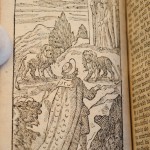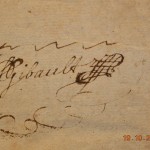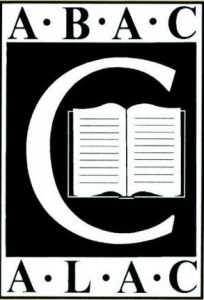Bunyan, John. The Pilgrim’s Progress From This World to That Which is to Come: Delivered Under the Similitude of a Dream &c. / Three parts bound together, the third part also with A Life and Death of Bunyan.
London: Robert Ponder; J. Deacon, 1689; 1690; 1693. pp. 204; (11) 180; 155 + 44 + ads (3). 12mo. Early rebind in full leather, showing typical trimming of margins. 15 engravings: 13 in Part I (two missing); one each in Parts II (at p.47) and III (frontispiece). Front board detached, some spotting to text, missing p. 73-6 & 123/4 of Part I, as well as p. 147/8 of Part II, as is common for seventeenth-century editions of this title. Leather Bound. Signature of “P Gibault” on the front endpaper, could be ascribed to Father Pierre Gibault (1737-1802), 18th century Jesuit missionary and priest.
Part I: Robert Ponder 1689 12th edition: containing 13 of the 15 called-for plates (Brown), this is the first edition of Part I to be published by Robert Ponder, after Nathaniel’s last publication of this title in 1688 though some later editions were again attributed to Nath. Ponder (Brown), and only the second edition issued with plates, including twelve additional and the three previously available plates for each of which A shilling extra had been charged. Part II: Robert Ponder 1690 3rd edition: bearing Bunyan’s dialogue warning the reader of the pirated editions which were by that time numerous. Part III: J. Deacon 1693 1st edition: matching points noted for “Supposititious Works” in Harrison, and “Imitations”, as in Brown. This third part was “was a brazen attempt to deceive”, with the preface signed “J.B.” and describing itself as The Third Part, to which is added The Life and Death of John Bunyan. “Despite the strong denunciation of it printed in the form of a publisher’s advertisement on the reverse of the title-page in the thirteenth edition, 1693, no fewer than fifty-nine editions of it had appeared before the end of the eighteenth century”. (Brown) John Bunyan (1628-1688) was the son of a tinsmith, who spent his early years as “a great sinner: “I was the very ringleader,” he claimed, “in all manner of vice and ungodliness”.” (Jenkins) He became a believer and a Baptist minister, and was imprisoned in the Bedford gaol for non-Anglican worship. He wrote his masterwork while in prison, an allegorical tale which quickly became a “universally loved…parable of salvation”, as well as foundational to the English working-class movement. (PMM) See: Brown “John Bunyan: His Life, Times, and Work”; Owens, “Reception, Appropriation, Recollection: Bunyan’s Pilgrim’s Progress”; Wharey (intro.) “The Pilgrim’s Progress”; Harrison, “A Bibliography of the Works of John Bunyan”; Simonova, ” Passing Through Vanity Fair: The Pilgrim’s Progress in the Marketplace”; Carter & Muir, “Printing and the Mind of Man”; Jenkins, “Works of Genius”, 57. (#035697) $17,500.00






You must be logged in to post a comment.